Time: 11:00AM – 6:00PM
Location: Small island below MM12 up to fast water below MM12; tree rock and angled riffle
Fish Landed: 27
Frying Pan River 09/23/2013 Photo Album
Occasionally the fishing gods smile upon us humble fishermen, and Monday proved to be such a day, but before getting to that part of the story, more on the weather. While sleeping at The Green Drake in Basalt I awoke periodically to the sound of rain pounding down on the roof and as the morning drew near, these periods of heavy rain continued. Would we be able to fish in these wet rainy conditions?
We killed some time by paying for another night’s stay at The Green Drake and then proceeded down the street to Saxy’s coffee shop for some tea. After our morning tea we returned to the hotel and prepared lunches as we were optimistic that the weather would clear based on Jeff’s review of the satellite weather imagery. It remained quite overcast with ongoing periods of moderate rain and drizzle. Next we drove to Aspen to check on a medical issue and then returned and headed back up the Frying Pan River Valley to the upper 2.5 miles below the dam. Here we found a parking place in the large guide lot which only contained two other cars at 10:30 in the morning. Jeff overheard a guide saying that Frying Pan Anglers experienced three cancellations due to the rainy weather, so perhaps the morning rain would keep some of the fishermen off the water.
Jeff decided to begin fishing near the parking lot, but I elected to walk down the road to the small island just below MM12 where I angled on the path that meets the smooth pool at the bottom of the left braid around the island. At this point I proceeded down the fast water to the bottom point of the island and then began fishing my way up the right channel which contained more favorable volume at the low 115 cfs flow rate. I began once again by prospecting with a green drake and alternated between the size 14 parachute green drake and a size 14 comparadun. I used the parachute pattern with the easily visible white tipped wing post in the faster water and switched to the comparadun in smooth water.
When I arrived at the large pool at the top of the island with the large rectangular rock I substituted an even smaller comparadun for the one that I used previously, and this comparadun seemed smaller than others that I tied because it was not tied on a 2XL hook and it had a lighter tan wing. This comparadun produced far better than the darker winged version and the combination of green drake flies delivered eight fish to my net by approximately 12:30. Meanwhile it was quite chilly but the sky was brightening and the sun peeked through the large puffy gray clouds on a more frequent basis. The weather was changing but presistent wind and breezes were part of the clearing equation.
At around 12:30 a BWO hatch commenced in the large pool and I was still positioned at the tail and continuing to prospect with my green drake imitations, but the fish were either wise to my fraud or had switched to another food source. Within a few minutes the BWO hatch thickened and the pool came alive with rising fish. The fish in the faster current along the main run down the center of the pool rose sporadically and I could see them underwater moving and perhaps feeding on subsurface nymphs and emergers. More of interest to me were two very visible brown trout that began sipping BWO’s along the smoother left side of the large pool where the current fanned out below a large protruding rock. These fish were directly above my position so I tied on a CDC BWO and began making casts above the two fish. I was careful to shoot my casts high and check them early so the fly fluttered down with plenty of slack tippet. It took quite a few casts and patiently watching these fish snatch natural duns within inches of my fly, but eventually I duped and landed both fish, an accomplishment that I was quite proud of.
By 1PM the BWO hatch had abated somewhat although with the overcast skies it never truly stopped, so I used this period to quickly down my lunch next to the rectangular rock pool. After lunch I waded closer to the top of the pool where the faster water entered and I began to notice a larger mayfly mixed in with the BWO’s. As I looked on I observed a brown trout ten feet in front of me drift back sipping BWO’s and then a larger mayfly fluttered on the suface, and the feeding brown slurped that in as well. Clearly the fish were tuned into this larger mayfly in addition to the BWO’s, and this natural was larger than the BWO’s but smaller than green drakes. I spotted another one drifting on the suface toward me and was fortunate enough to scoop it off the surface with my net for closer observation.
The mayfly appeared to be a size 16 with a light olive/maroon body so I began searching through my fly boxes, especially the two that contain comparaduns that I tied for the many mayflies that hatch in Pennsylvania. Buried along the edge of one of these boxes was a size 18 comparadun with a body blended with light olive and maroon dubbing. The resultant color was a shade of cinnamon with tinges of olive. At this point I thought I had only one of these so I tied it on my line and began to cast it over rising fish. What a choice! Over the next hour and a half I landed twelve nice fish on the one fly wonder, and I was careful to not damage it too much with each release. Several of the fish were in the 14-16 inch range and the remainder were chunky twelve inch browns. At one point I felt abrasions on the tippet near the eye of the hook so I clipped off an inch of monofilament and reknotted the valuable comparadun with smooth line. I rarely pay this much attention to line damage.
I moved above the long narrow island and fished the pockets along the left side of the river, but because the flows were lower than normal based on past trips I was able to wade across to the south side and explore new water that is typically out of reach at higher flows. It was in this area between the top of the large rectangular rock pool and one of the larger pools along the right side that I experienced the success with the olive/maroon comparadun.
There were two nice pools that formed along the south bank where significant current breaks allowed the water to fan out and provide nice feeding stations for hungry trout. The lower pool was smaller and had a branch angling upstream from just below the tail. Here I spotted four or five trout rising regularly and I managed to fool and land several on the size 18 comparadun, but the nicest fish cruised about the pool in a small circle and periodically sipped a fly off the surface. I worked this fish relentlessly, probably longer than I should have during a nice hatch when other fish were more willing to cooperate with my efforts. Unfortunately I couldn’t time my casts, avoid drag and predict where the fish was moving and eventually conceded and moved on.
Just above this smaller pool was the larger wider version and this also contained some visible fish. The most visible was a large fish that resided in a deep depression at the very tail of the pool next to a large rock that extended from the bank. The water in the pool funneled through this narrow deep trough before pouring downstream. I observed this fish rising occasionally, but my magical comparadun was not of interest. At this time I also noticed two green drake naturals on the surface of the water so I removed my valued comparadun (the wing had by now been reduced to a small cluster of five deer hair fibers), and replaced with the size 14 comparadun with the tan wing, and cast to some decent water to my left and above me and landed two medium sized browns.
My eyes returned to the big guy in the trough and again I observed a sipping rise. I ran a few drifts of the comparadun green drake over the large target, but they were ignored. Jeff had given me three green drake flies that he purchased at Taylor Creek Fly Shop so I decided to try one of them on this stubborn fish right in front of me. I nervously removed my comparadun and tied on the purchased version with a tall dark gray CDC wing and yellow hackle wound parachute style around the wing post. This fly looked quite similar to the naturals while on the water as it created the illusion of fluttering movement similar to the ones that floated by.
I flicked a short cast above the fish and as it drifted toward the target, the large fish drifted up and sucked it in! What a visual moment! Somehow I remained under control and waited for a second or two so as not to pull the fly out of the fish’s mouth. Now the battle was on and the rainbow charged up and down the pool and thrashed vigorously from time to time, but much to my relief it never attempted to escape the pool and swim into faster water. I carefully lifted the thrashing fish so its nose was above the water and quickly slid my small net opening beneath the long body and the net bowed out with the weight and length of an eighteen or perhaps nineteen inch rainbow. In addition to the discovery of an effective fifteen year old fly, I had now landed perhaps my longest fish of the summer.
This pool was actually the last piece of good water along the right side so I backtracked along the bank and crossed above the island and fished the deep pocket above the island on the left side with the purchased green drake and landed a few more fish. At this point it was 4PM so I exited and walked down the road to “tree rock” pool, a nice small pool with a large protruding square rock at the center top with a small tree growing from it. I spotted two fish below the rock and made some solid casts with the green drake but they ignored it and seemed to be focused on smaller food. I acknowledged their preference and removed the green drake and tied on a CDC BWO and placed some casts over the fish in tree rock pool, but they were not interested so I turned my attention in the direction of angled riffle.
I was positioned in the middle of the river and to my right was a nice wide riffle where much of the river angled toward the south bank and then deflected and ran swiftly along the bank for twenty feet. From past experience I knew these riffles held quite a few nice fish so I began drifting my BWO along the current seams sequentially covering the water closest to me and then extending away. This search yielded a nice rainbow on the BWO but other visible fish were not reacting. After I’d worked the area for awhile Jeff arrived and began making downstream casts from the bank next to the road, and he experienced some success.
I was quite chilled and weary at this point with quite a successful day behind me, so I wandered back to the car and left the area for Jeff. When I arrived at the lot I noticed that Jewel Pool directly across from the parking lot was void of fishermen, so I decided to wade part way across the riffles and give it a try. I spotted small tan wing caddis on the water, so I tied on a light gray caddis and prospected with that for a bit, but it only generated refusals. Suddenly the pool came alive with slashing fish that occasionally broke the surface and I noticed some fairly large midges flying by. These natural insects appeared to approximate size 20 flies, so I tied on a Chernobyl ant as my indicator and then added a trailing zebra midge larva. This did not generate a response but the fish continued to slash and move subsurface for something. I clipped off the midge larva and replaced it with a griffith’s gnat, and once again my flies were simply treated like floating leaves or debris. Nothing was working and it was getting quite cold so I called it a day and retreated to the car and waited for Jeff who arrived fairly soon thereafter.
On this chilly autumn Monday I experienced some great surface action and landed 27 fish on green drakes, PMD’s and BWO’s. I discovered an old fly that was eaten like candy and I landed a 19 inch rainbow. It was certainly one of my better days on the Frying Pan River.

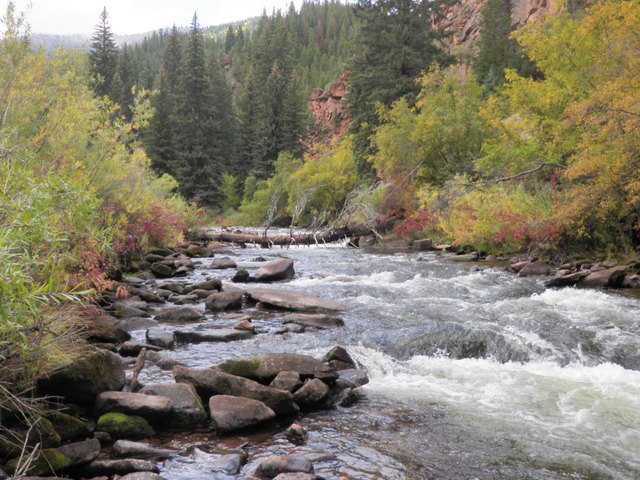
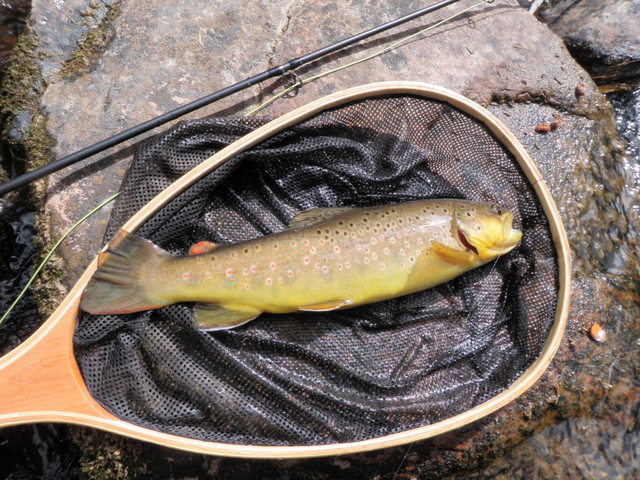
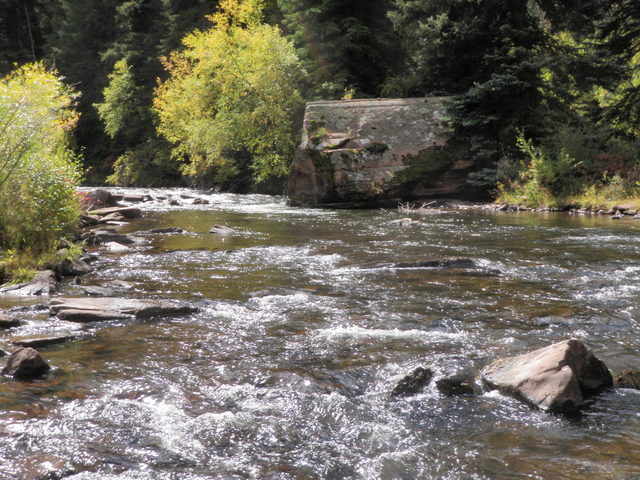
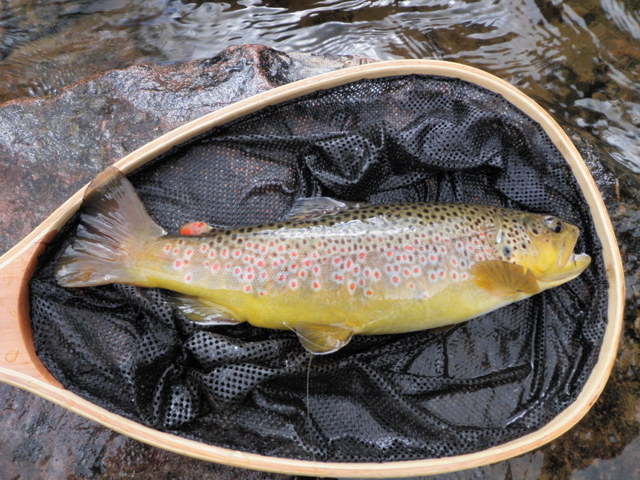
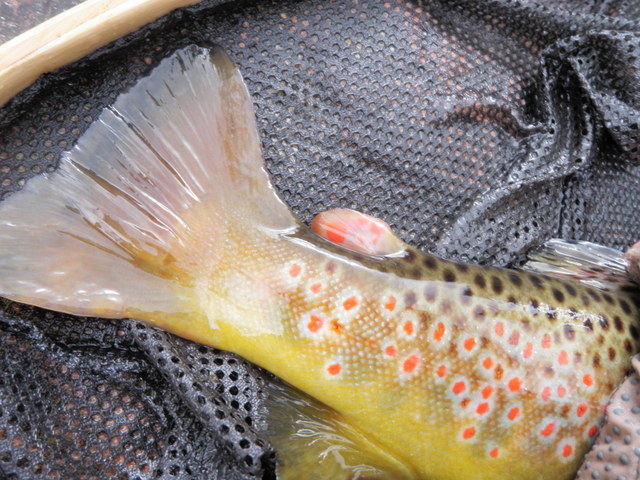
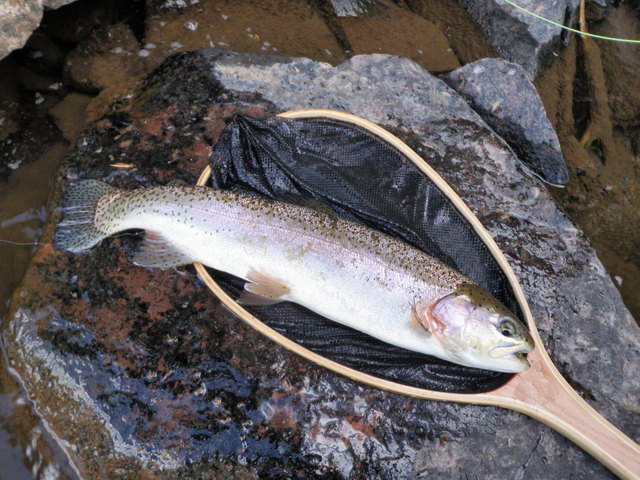
Dave – Awesome story… so glad to hear the Jeff/Dave team connected in such a meaningful way. 27 fish in a season is pretty good number for us PA fisherman (excluding Jeff)… hard to imagine that in one day !!! great job… great stories.
I want some pictures of those flies… and I assure you that I will be taking a look for the rectangular rock on my next trip… Continue to have fun before the snow flies !
Thinking of you guys… the Other Dave
Thanks Dave. I can’t wait to join you on the Frying Pan the next time you are able to come to Colorado.
Dave
Pingback: Cinnamon Comparadun – 02/01/2015 | Dave Weller's Fly Fishing Blog